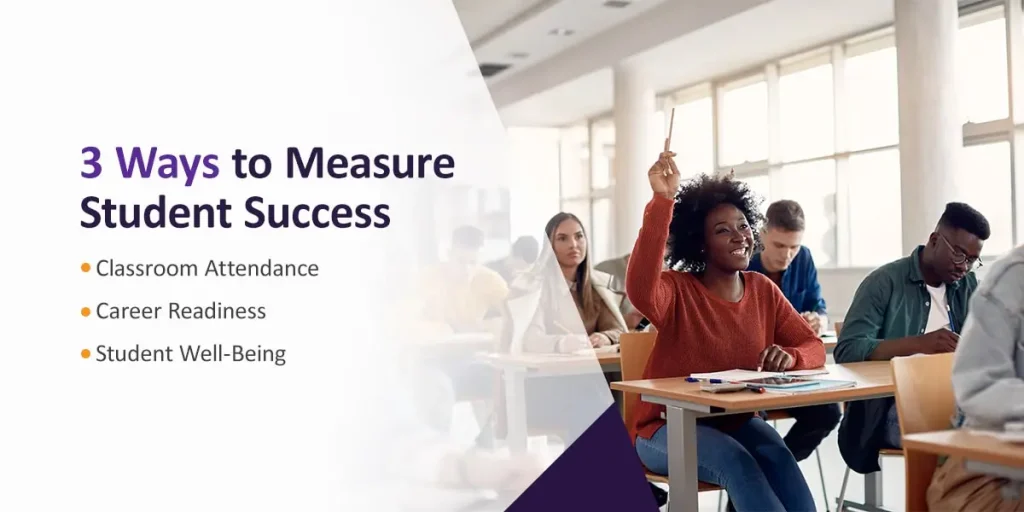As an administrator, you have firsthand insight into today’s college landscape. Students are eager and motivated but are struggling with more health and financial-related stressors than ever before. As educational systems have changed with evolving technology and workforces, so has the idea of a successful student.
Student success goes beyond high marks, test scores, and graduation rates. In today’s higher education institutions, administrators must consider the whole picture, including institutional statistics and retention rates, classroom performance, career readiness, and each student’s holistic wellness.
How Do We Define Student Success?
One metric for identifying student success is to explore institutional statistics, including student graduation rates, degree attainment, and retention rates. Those numbers have shifted in recent years, with more than a million students dropping out of college each year and overall enrollment down more than 600,000 students over a 12-month period.
Four-year universities aren’t the only ones seeing these changes — only 62% of students enrolled in fall semester courses at a public two-year community college in 2018 were still enrolled in a college program one year later.
Are these figures a true reflection of university and community college student success or a facility’s overall effectiveness as an educational institution? Many factors are at play in declining college rates, including the increased availability of more nontraditional educational options for adults.
It’s time to shift which student success factors administrators consider as part of their institutional analysis to get a true understanding of student performance and well-being.

3 Ways to Measure Student Success
One accurate way to analyze institutional effectiveness involves students’ career readiness, including skills and general subject matter competency to determine student success. This career readiness should not be at the expense of student well-being. In fact, all aspects of student well-being should be another metric for measurement. Classroom attendance may offer opportunities for early intervention and success forecasting.
1. Classroom attendance
Reports have linked student absenteeism with gaps in academic performance, but tracking class-specific attendance data can be challenging for schools with large classes.
- Have flexible attendance options: Integrate flexible attendance options for classes and campus-wide services, like tutoring and wellness amenities, whenever possible. For example, investing in technology to give professors the option to host online class streaming for students unable to attend in person can help overcome weather- or sickness-related student absences.
- Be understanding of nuance: Absences happen for various known and unknown reasons, ranging from students having other obligations to serious illness, loss, or other concerns.
- Have an outreach plan: Have an outreach plan in place to address frequent or unexplained absences to stop potential student spirals before learners fall behind. Your outreach program should include an intervention benchmark and plan, including tracking attendance and knowing when the right time to intervene is. Know the method you’ll reach out with, such as a quick email, an in-person chat with administration, or a special outreach group. Offer coaching services to help struggling students get back on track with missed assignments or classroom work.
2. Career readiness
A student’s career readiness includes their practical skills, competency assessments, internships, lab work, and similar aspects. Career readiness also includes:
- Work ethic
- Leadership skills
- Critical thinking
- Problem-solving
- Written and verbal communication
- Accountability
- Personal character
- Professionalism
- Diverse idea inclusion
- Technology experience
Use early warning systems like diagnostic reports and data analysis to measure factors affecting student success in college and how each factor impacts progress toward career readiness. Examples include standardized testing, capstone projects, and thesis work.
Your administration should strive for consistency in all areas to avoid confusion and promote student success. Start with a strong, easily understood set of standards and communicate those to professors and students for each discipline and degree program.
3. Student well-being
Physical illnesses — like colds and influenza, disorders, and addictions — are hard to combat at an administrative level. In most cases, the best thing you can offer students is a free-to-use, on-site student wellness center with a staffed nurse and access to over-the-counter medications and help arranging doctor’s appointments or emergency care.
One rising complication colleges should create a plan for is mental health. Consider these statistics about students’ mental well-being:
- A majority of surveyed students are struggling with anxiety, social isolation and loneliness, depression, concentration troubles, and stress management.
- One in five surveyed students reported having suicidal thoughts in the past month.
- Almost half of survey respondents screened positive for significant depression and anxiety symptoms, the highest number since a similar survey in 2007.
With such alarming figures, what can administrators do to help students stay mentally healthy? A survey among students from The Jed Foundation showed the usefulness of specific campus efforts:
- Thirty percent of respondents rely on counseling, with nearly half of those citing virtual support groups and online counseling options as a better choice.
- Fifty-two percent of students benefited from regular wellness check-ins with school administrators.
- Seventy-one percent of students noted tele-mental health services as playing a critical role in managing their mental well-being.
Make an effort to offer students flexible counseling options, including in-person and virtual visits. Implement campus-wide outreach programs like community support groups and administrative check-ins to help identify struggling students and offer guidance and further resources.
Strategies for Supporting Student Success at Your Educational Institution
Achieve student success by implementing free, consistent strategies for learners enrolled part-time and full-time. Use these guidelines and suggestions:
- Know your students: How an administration measures student success may differ from how each student views their individual success inside of and beyond the classroom. Familiarize yourself with your students to understand what their goals and concerns are and learn how you can best support them with resources like academic centers, career development services, technology labs, housing and food assistance, networking events, and more.
- Hold community events: Hold campus-wide events to foster a sense of community to help students connect with one another, form crucial networking connections, make friends, and find support for their well-being. You can also use public events to inform students about all the resources available to them, including campus health services, stress management events, and more.
- Involve the administration: Encourage professors and administrators to get to know students on a personal level so you can be better prepared to intervene after unexplained absences or at the first signs of physical or mental health deterioration.
- Make student-focused decisions: Ensure every decision you make as an administration is student-focused. How can you best support your students? What’s truly in their best interest? What do they need from you? Institutional goals and resources should align with these wants and needs, with clear expectations and open communication along the way. This process may require reviewing and revising current strategies and policies to identify areas for improvement or increased resource spending.
Request a Demo From Watermark Today

Contact Watermark today to learn how our Student Success & Engagement solution offers insights into student success metrics . We’ll help you pave the way toward better student outcomes and thriving academics. Request a demo today!















































































































































































































































































































































































































